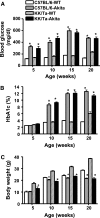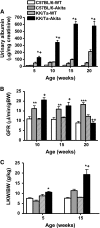Reduction of renal superoxide dismutase in progressive diabetic nephropathy
- PMID: 19470681
- PMCID: PMC2689908
- DOI: 10.1681/ASN.2008080844
Reduction of renal superoxide dismutase in progressive diabetic nephropathy
Abstract
Superoxide excess plays a central role in tissue damage that results from diabetes, but the mechanisms of superoxide overproduction in diabetic nephropathy (DN) are incompletely understood. In the present study, we investigated the enzyme superoxide dismutase (SOD), a major defender against superoxide, in the kidneys during the development of murine DN. We assessed SOD activity and the expression of SOD isoforms in the kidneys of two diabetic mouse models (C57BL/6-Akita and KK/Ta-Akita) that exhibit comparable levels of hyperglycemia but different susceptibility to DN. We observed down-regulation of cytosolic CuZn-SOD (SOD1) and extracellular CuZn-SOD (SOD3), but not mitochondrial Mn-SOD (SOD2), in the kidney of KK/Ta-Akita mice which exhibit progressive DN. In contrast, we did not detect a change in renal SOD expression in DN-resistant C57BL/6-Akita mice. Consistent with these findings, there was a significant reduction in total SOD activity in the kidney of KK/Ta-Akita mice compared with C57BL/6-Akita mice. Finally, treatment of KK/Ta-Akita mice with a SOD mimetic, tempol, ameliorated the nephropathic changes in KK/Ta-Akita mice without altering the level of hyperglycemia. Collectively, these results indicate that down-regulation of renal SOD1 and SOD3 may play a key role in the pathogenesis of DN.
Figures






References
-
- Krolewski AS: Genetics of diabetic nephropathy: Evidence for major and minor gene effects. Kidney Int 55: 1582–1596, 1999 - PubMed
-
- Freedman BI, Bostrom M, Daeihagh P, Bowden DW: Genetic factors in diabetic nephropathy. Clin J Am Soc Nephrol 2: 1306–1316, 2007 - PubMed
-
- Brownlee M: The pathobiology of diabetic complications: A unifying mechanism. Diabetes 54: 1615–1625, 2005 - PubMed
-
- Brownlee M: Biochemistry and molecular cell biology of diabetic complications. Nature 414: 813–820, 2001 - PubMed
-
- Li JM, Shah AM: Endothelial cell superoxide generation: regulation and relevance for cardiovascular pathophysiology. Am J Physiol Regul Integr Comp Physiol 287: R1014–R1030, 2004 - PubMed
Publication types
MeSH terms
Substances
Grants and funding
LinkOut - more resources
Full Text Sources
Other Literature Sources
Medical
Molecular Biology Databases
Miscellaneous

